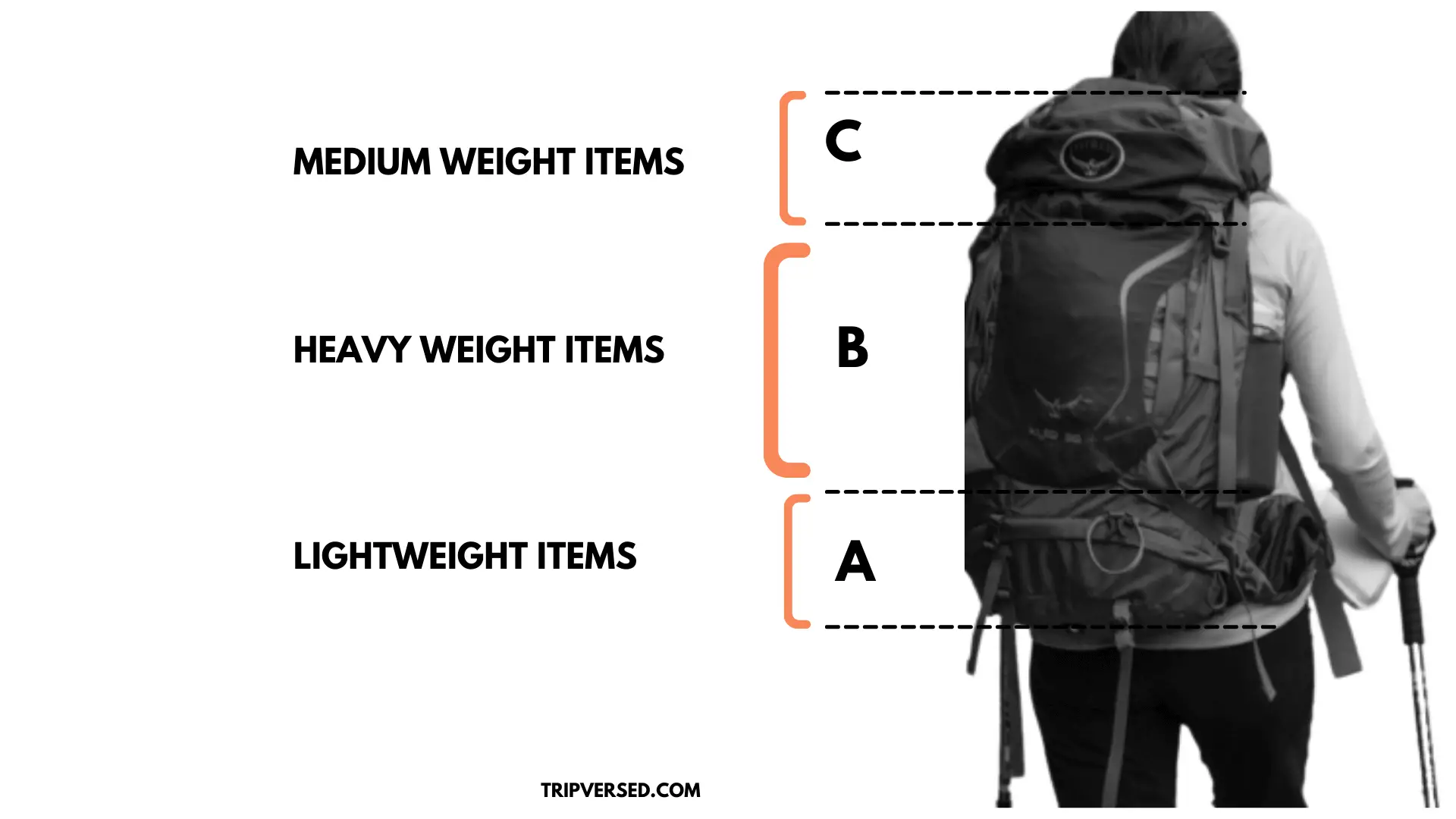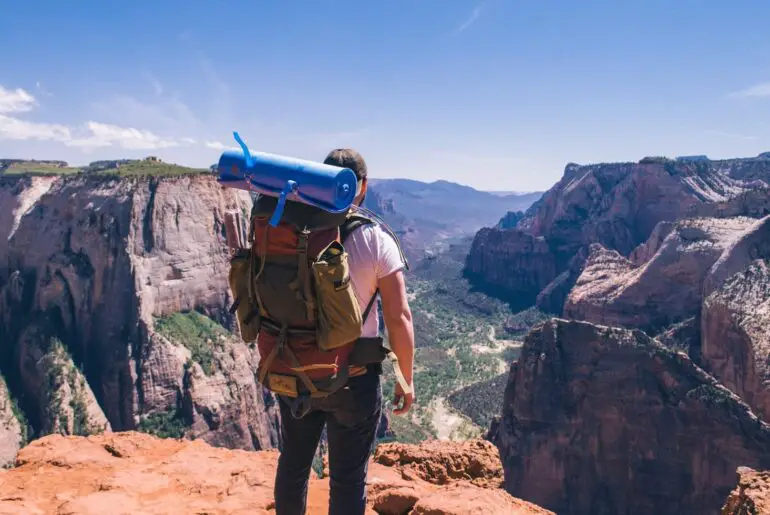Last Updated on January 30, 2023 by Rose Morah
We all know the number one rule of backpacking is to carry less. But most people are always caught up in the dilemma of choosing what to and not to carry.
This is because for some reason we always feel like we will need everything during our backpacking or hiking trip.
To help you decide between what to carry and what to leave, we have listed 10 must-have backpacking essentials for your trip.
And so, in this article, we will cover:
- What to pack for a short and long hike.
- How to pack light for backpacking
- How to pack a trekking backpack
- What not to bring on a hike.
Related: 11 Backpacking & Hiking Tips When Out of Shape or Overweight.
We will start off with what to pack for a short and long hike.
Must-have backpacking essentials for long and short hikes
- Navigations – a compass map.
- Shelter – tent, hammock, tarp, etc.
- First aid kit.
- Poop kit –this includes toilet paper, towels, etc.
- Toiletries – toothpaste, toothbrush.
- Water.
- Cook kit e.g stove.
- Fire e.g Lighter.
- Knife.
- Headlamp.
- Extra food. Stored in a bear canister.
- Extra clothing –this includes socks.
- Extra shoes.
- Sun protection – sunscreen, cap.
- Bear spray.
This checklist will help you pack light and what is necessary on your backpacking trip.
| Ensure that you only carry the most portable items. These items are easily available in the market. These include; shelter, pillows, a First Aid kit, food storage, water storage, Knife, headlamp, stove e.t.c |
Here is our best portable backpacking cookware

For only $27.99, you can get 16 pieces of camping cookware kit. These includes:
- Folding stainless steel spoon, spork, and knife.
- Mini stove with piezo ignition.
- Non-stick pot.
- Non-stick frying pan.
- Pan cover.
- 2 bowls.
- Soup spoon.
- Loofah sponge.
- Rice ladle.
- Carabiner.
- Nylon bag.
The best thing about this cookware set is that they can all be packed together, which saves you space in your backpack.
When it comes to water storage, personally, I store my water in a water reservoir. This way I am able to easily connect the tube from the bag and take some sips of water as I hike. The good thing is, it does not leak.
This is what I use and would recommend to other backpackers.
3 Liter
See also:
The Ultimate Women’s Safari Packing List.
Best Packable Women’s Sun Hats.
How to pack a trekking backpack
Packing a trekking backpack does not feel like something you need to be keen on. But trust me, it is important.
A well-packed backpack makes the backpack feel lighter, especially when the weight is well-balanced across the backpack.
On my first backpacking trip, I remember trying to fit all my hiking gear in my backpack which was completely full. I had not even packed my food and water. I kept repacking until everything fit in. The whole backpacking experience ended up so miserable because of the back and shoulder pains that I got.
The experience challenged me to research other better ways to pack and balance the weight of the backpack to help get rid of the back and shoulder pains.
So, here’s how to pack your trekking backpack;
First, you will need to know how to distribute the weight in your backpack. The image below shows an illustration of how to distribute the weight of your backpack.

You may also like: How to Find Overlanding Trails (Best Tools & Resources for Finding Trails).
1. Carry lighter items at the bottom of your backpack.
This includes your sleeping items – a light sleeping bag, sleeping clothes e.t.c
2. Carry heavier items in the middle of your backpack.
Packing heavier items in the middle helps distribute the weight throughout the bag. This also helps eliminate back and shoulder pains.
Personally, I like to put my bear canister that is full of food, a cooking kit, a stove, and a reservoir full of water in the middle of the backpack.
I then put my clothes around the sides of the bag to prevent the items in the middle of the bag from moving around while I am hiking or walking.
3. At the top of the bag, put items that you would need easier access to.
These items include;
- Shelter e.g tent.
- Extra hiking shoes.
I normally put the tent at the top because it will be easy to access it if the weather suddenly changes. And sometimes when trekking under the hot sun with nowhere to rest under a shade, it is easy to set up a tent to rest.
You can also strap the tent to the bag and put items that you will need easier access to, like a jacket, on the top of the backpack in case it gets cold.
| Make sure your tent and sleeping bag are in a secondary waterproof bag. This can be a garbage bag or a dry sack. |
I also like to put my extra hiking shoes at the top, just in case I will be crossing a river.
4. On the outer pockets I put:
- My poop kit.
- Water filter bottle.
- Bear spray.
The water bottle should be in the outside pocket. This way you avoid unpacking your items whenever you’re thirsty or want to hydrate. Additionally, you don’t want your clothes getting wet in case it leaks.
5. On the outer shovel pocket.
Here, you can pack your raincoat, my map e.t.c.
See also: Best Duffle Bag for African Safari (Features and Requirements).
What not to bring on a hike
When packing, here is what not to bring on a hike.
- More than two pairs of jeans.
- More than one warm jacket.
- Bulky towel–Sometimes if your bulky towels smell everything in your backpack ends up smelling.
- Pillow – You can easily make a simple pillow from a small and light pillowcase by putting it in your hiking clothes.
- Complete cookware – set plates, bowls, spoons, more than one pot, pans e.t.c
- Makeup and jewelry.
- Books.
- Too many spare items. No need to carry an extra stove.




